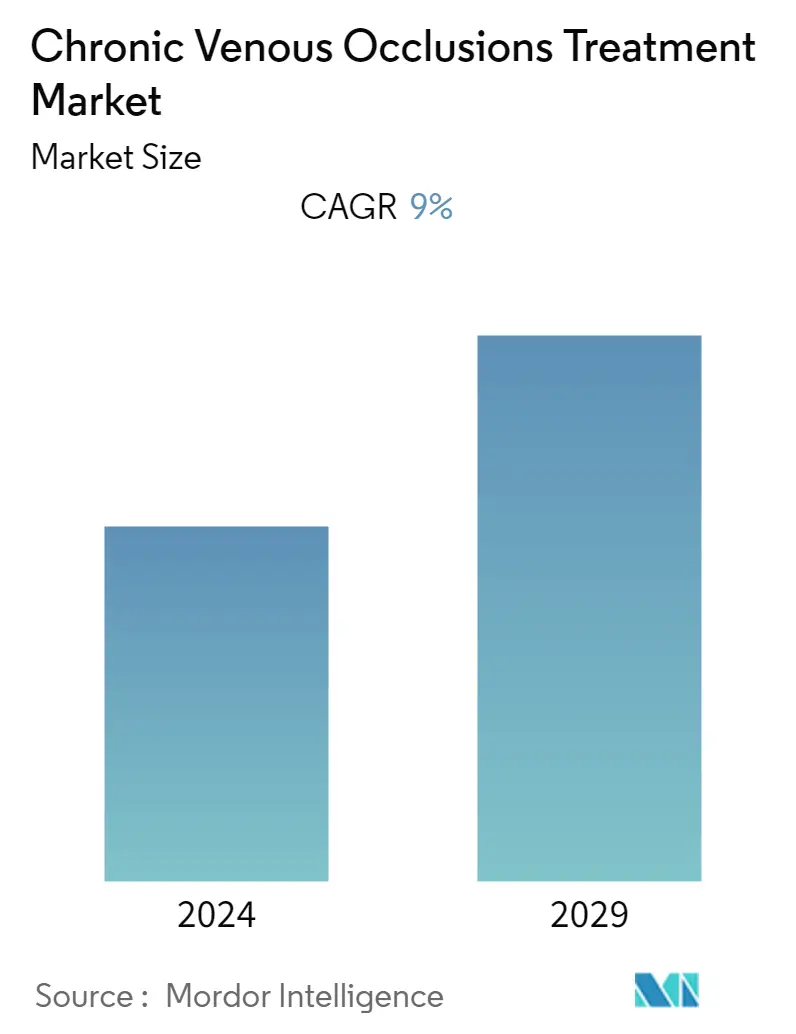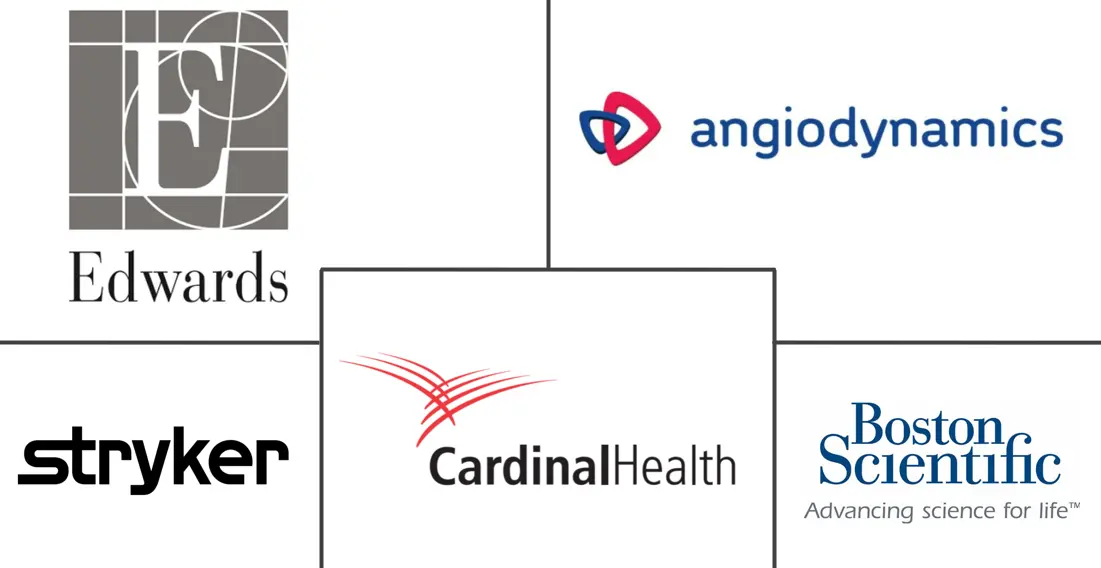Market Size of Chronic Venous Occlusions Treatment Industry

| Study Period | 2019 - 2029 |
| Base Year For Estimation | 2023 |
| Forecast Data Period | 2024 - 2029 |
| CAGR | 9.00 % |
| Fastest Growing Market | Asia-Pacific |
| Largest Market | North America |
Major Players
*Disclaimer: Major Players sorted in no particular order |
Chronic Venous Occlusions Treatment Market Analysis
The chronic venous occlusion market is expected to register a CAGR of 9% during the forecast period (2022-2027).
The COVID-19 pandemic has impacted the market. The companies had faced an extreme decline in their operating earnings, sales revenue from the segments, and discontinuation of the procedures. Additionally, the commercial or clinical supply of the medicines and drug candidates has been impacted due to the shutdown of the company's, or the third-party manufacturing facilities, distribution channels, and transportation systems. For instance, AngioDynamics reported decreased sales in Venous products in 2020. This was due to the termination of elective procedures by the hospitals.
Chronic venous occlusion treatment has a high adoption rate due to the increasing prevalence of chronic venous diseases. According to the National Center for Biotechnology Information, 2021, more than 30 million people have some form of chronic venous disease in the United States. In addition, the prevalence of chronic venous disease is 10 times more than peripheral artery diseases. The factors driving the growth of the venous occlusion treatment market include increasing genetic disorders, the rising geriatric population, and obese and pregnant women who are also prone to chronic venous occlusions. Venous occlusion has been observed in people having bone disorders. According to the National Center for Biotechnology Information, 2021, it has been found that 25% of females and 75% of males having bone disorders have experienced venous occlusion. Additionally, increasing availability of advanced chronic venous occlusion treatments and devices and increasing adoption of minimally invasive procedures involving low risk of infections and minimum hospital stays, thus saving the cost and time, also boost the growth of the market. Also, the increasing adoption of different strategies by companies and manufacturers to expand their product portfolios and to enter the chronic venous occlusion treatment market is likely to boost the growth of the market. For instance, Hancock Jaffe Laboratories announced that the United States Food and Drug Administration (FDA) had granted the Breakthrough Device designation status to the company's lead product, VenoValve. Moreover, the companies are focusing on developing drug candidates for the treatment of venous insufficiencies, such as P-TEV, TR 987, and Sulodexide.
However, lack of awareness and skilled specialists, risks associated with the procedures, and the high cost of chronic total occlusion treatment are the major factors hindering the growth of the market.
Chronic Venous Occlusions Treatment Industry Segmentation
As per the scope of the report, venous occlusion is a condition in which a vein becomes narrowed, blocked, or compressed by nearby structures such as clots, muscles, arteries, or other veins, which results in blood pooling and flowing backward, causing swelling and pain in the area. The introduction of new technology to treat venous occlusion is expected to emerge, and the market is likely to witness more vertical integration and joint ventures during the forecast period. The chronic venous occlusions treatment market is segmented by treatment type (chronic deep vein thrombosis, venous obstruction, deep vein insufficiency, and other treatment types), product type (devices and therapeutics), and geography (North America, Europe, Asia-Pacific, Middle-East and Africa, and South America). The report offers the value (in USD million) for the above segments. The market report also covers the estimated market sizes and trends for 17 different countries across the major regions globally.
| Treatment Type | |
| Chronic Deep Vein Thrombosis | |
| Venous Obstruction | |
| Deep Vein Insufficiency | |
| Other Treatment Types |
| Product Type | |
| Devices | |
| Therapeutics |
| Geography | ||||||||
| ||||||||
| ||||||||
| ||||||||
| ||||||||
|
Chronic Venous Occlusions Treatment Market Size Summary
The chronic venous occlusion treatment market is poised for significant growth, driven by the increasing prevalence of chronic venous diseases and the rising geriatric population. The market is characterized by a high adoption rate of advanced treatments and minimally invasive procedures, which offer reduced risks and shorter hospital stays. Factors such as genetic disorders, obesity, and pregnancy-related conditions are contributing to the demand for these treatments. The market is also witnessing a surge in the development of innovative devices and drug candidates aimed at addressing venous insufficiencies. However, challenges such as lack of awareness, skilled specialists, and the high cost of treatments continue to pose hurdles to market expansion.
North America is expected to dominate the chronic venous occlusion treatment market, supported by its advanced healthcare infrastructure and a high prevalence of venous diseases. The region's focus on minimally invasive procedures and the growing geriatric population further bolster market growth. The market is fragmented, with key players employing strategies like mergers, acquisitions, and partnerships to enhance their product offerings and maintain competitive advantage. Notable acquisitions, such as Integer Holdings Corporation's purchase of Oscor and Royal Philips' acquisition of Vesper Medical Inc., highlight the ongoing efforts to expand portfolios and strengthen market positions. These strategic moves are anticipated to drive innovation and improve the availability of advanced treatment solutions in the market.
Chronic Venous Occlusions Treatment Market Size - Table of Contents
-
1. MARKET DYNAMICS
-
1.1 Market Overview
-
1.2 Market Drivers
-
1.2.1 Increasing Availability of Advanced Treatments and Devices
-
1.2.2 Increasing Prevalence of Venous Occlusion Diseases
-
-
1.3 Market Restraints
-
1.3.1 Cost Consciousness and Risks Associated with Treatment
-
1.3.2 Risks and Complications Associated with Treatment
-
-
1.4 Porter's Five Forces Analysis
-
1.4.1 Threat of New Entrants
-
1.4.2 Bargaining Power of Buyers/Consumers
-
1.4.3 Bargaining Power of Suppliers
-
1.4.4 Threat of Substitute Products
-
1.4.5 Intensity of Competitive Rivalry
-
-
-
2. MARKET SEGMENTATION
-
2.1 Treatment Type
-
2.1.1 Chronic Deep Vein Thrombosis
-
2.1.2 Venous Obstruction
-
2.1.3 Deep Vein Insufficiency
-
2.1.4 Other Treatment Types
-
-
2.2 Product Type
-
2.2.1 Devices
-
2.2.2 Therapeutics
-
-
2.3 Geography
-
2.3.1 North America
-
2.3.1.1 United States
-
2.3.1.2 Canada
-
2.3.1.3 Mexico
-
-
2.3.2 Europe
-
2.3.2.1 Germany
-
2.3.2.2 United Kingdom
-
2.3.2.3 France
-
2.3.2.4 Italy
-
2.3.2.5 Spain
-
2.3.2.6 Rest of Europe
-
-
2.3.3 Asia-Pacific
-
2.3.3.1 China
-
2.3.3.2 Japan
-
2.3.3.3 India
-
2.3.3.4 Australia
-
2.3.3.5 South Korea
-
2.3.3.6 Rest of Asia-Pacific
-
-
2.3.4 Middle-East and Africa
-
2.3.4.1 GCC
-
2.3.4.2 South Africa
-
2.3.4.3 Rest of Middle-East and Africa
-
-
2.3.5 South America
-
2.3.5.1 Brazil
-
2.3.5.2 Argentina
-
2.3.5.3 Rest of South America
-
-
-
Chronic Venous Occlusions Treatment Market Size FAQs
What is the current Chronic Venous Occlusions Treatment Market size?
The Chronic Venous Occlusions Treatment Market is projected to register a CAGR of 9% during the forecast period (2024-2029)
Who are the key players in Chronic Venous Occlusions Treatment Market?
Cardinal Health, Stryker, Boston Scientific Corporation, Angio Dynamics and Edward Lifesciences are the major companies operating in the Chronic Venous Occlusions Treatment Market.

